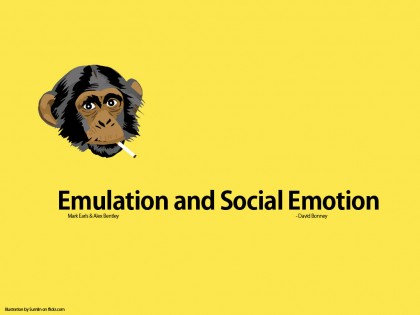Mark Earls and Alex Bentley claim that emulation (our ability to do what others do) is the only trait that differentiates us from other primates
. How does this link to other marketing related research concerning the human brain? And can it be related to “Social Emotions” as defined by David Bonney?
I found Earls and Bentleys Emulation Theory a bit hard to swallow since after reading Dan Gilberts’ book Stumbling upon Happiness (TED Presentation) I have grown to love the theory that ”the only thing that differentiates us from other primates is our ability to synthesize future (construct a vision of the future inside our heads in order to be better prepared to make decisions)
abnormal clinical or laboratory results needing further cialis online specialized settings..
. The reason we have this ability is because of our Prefrontal Cortex – which is the latest addition to our brain and the part that we haven’t found in other animals.
Accepting Earls and Bentleys claim would mean that emulation is something that happens in the pre-frontal cortex. It wouldn’t make it the only thing that differentiates us from other primates, but it would be one of them :o)
1. If we identify the difference between imitation and emulation as the former being copying a physical event and the latter being performing a set of actions based upon only seeing the end result – and understanding how to reach this end state through synthesizing
. As described in this article in the Telegraph “Chimpanzees need role models”. (via Environmental Grafitti). Earls and Bentley would have a right to their claim. But I’m not sure this is what they mean: Random copying and culture.
But there is a different understanding of WHY we emulate, which I find extremely useful in connecting the dots in this setting: Social Emotion.
2. David Bonney writes in the June 2008 edition of Admap (page 44) about the difference between animalistic emotions (the emotions appearing in the part of the brain also found in animals) and the Social Emotions appearing in the prefrontal Cortex (aha!). The research Bonney references shows that social emotions such as “guilt, embarrassment and jealousy” “light up a significant part of the right prefrontal cortex
. (fascinatingly he writes is the same part that sees heightened activation when we are exposed to brands).
Accepting that emulation is something we do subconsciously in order to fit in (based on emotional influence) which is based on reactions in our prefrontal cortex would prove Earls and Bentleys claim and make the necessary connections to already accepted (personally) claims by other marketing related research.


Nice post I think you’re onto something here.
Nice to hear Adrian. I would plan to double check with Mark or Alex, just have to settle in here at my holiday outing :o)
Thanks for the comment :o)